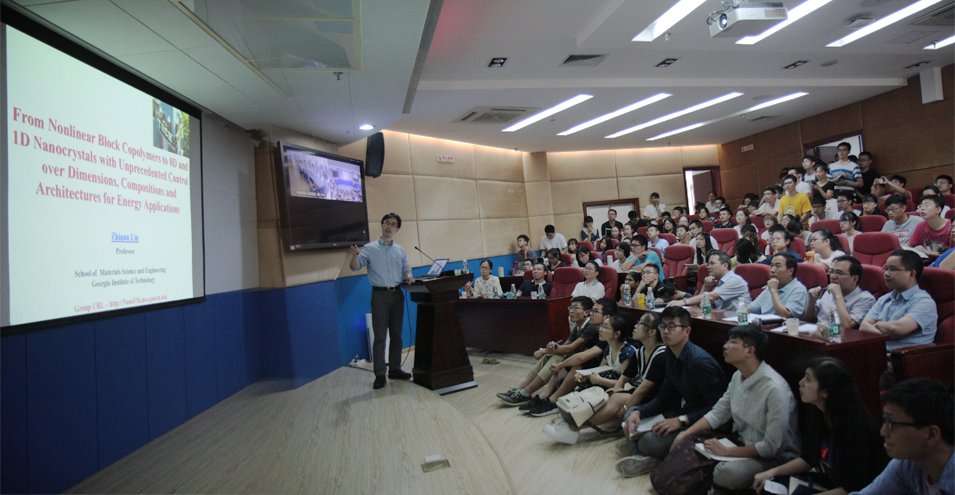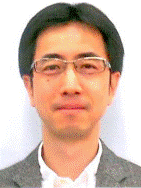Title: From Nonlinear Block Copolymers to 0D and 1D Nanocrystals with Unprecedented Control over Dimensions, Compositions and Architectures for Energy Applications
Speaker: Dr. Zhiqun Lin (Georgia Institute of Technology, USA)
Date/Time: 10:00 AM, Oct. 25, 2016 (Tues.)
Location: Room 202 in the Lujiaxi Building.

Abstract:
Nanocrystals exhibit a wide range of unique properties (e.g., electrical, optical, and optoelectronic) that depend sensitively on their size and shape, and are of both fundamental and practical interest. Breakthrough strategies that will facilitate the design and synthesis of a large diversity of nanocrystals with different properties and controllable size and shape in a simple and convenient manner are of key importance in revolutionarily advancing the use of nanocrystals for a myriad of applications in lightweight structural materials, optics, electronics, photonics, optoelctronics, magnetic technologies, sensory materials and devices, catalysis, drug delivery, biotechnology, and among other emerging fields. In this talk, I will elaborate two general and robust strategies for crafting a large variety of functional 0D and 1D nanocrystals with precisely controlled dimensions (i.e., plain, core/shell and hollow nanoparticles; plain and core/shell nanorods; nanotubes) by capitalizing on a set of rationally designed unimolecular star-like and bottlebrush-like block copolymers, respectively, as nanoreactors. These two strategies are effective and able to produce oil-soluble and water-soluble monodisperse nanoparticles and nanorods, including metallic, ferroelectric, magnetic, luminescent, semiconductor, and their core/shell structures, which represent a few examples of the kind of nanocrystals that can be produced using these techniques.1-3 The applications of these functional nanocrystals in energy conversion and storage (e.g., dye-sensitized solar cells, perovskite solar cells, thermoelectrics, etc.) will also be discussed.
Biography:
 Dr. Zhiqun Lin is currently Professor of Materials Science and Engineering at the Georgia Institute of Technology. He received the B.S. degree in Materials Chemistry from Xiamen University, Fujian, China in 1995, the Master degree in Macromolecular Science from Fudan University, Shanghai, China in 1998, and the PhD degree in Polymer Science and Engineering from UMass, Amherst in 2002. He did his postdoctoral research at UIUC. He joined the Department of Materials Science and Engineering at the Iowa State University as an Assistant Professor in 2004 and was promoted to Associate Professor in 2010. He moved to Georgia Institute of Technology in 2011, and become a Professor in 2014. His research interests include polymer-based nanocomposites, block copolymers, polymer blends, conjugated polymers, quantum dots (rods, tetrapods and wires), functional nanocrystals (metallic, magnetic, semiconducting, ferroelectric, multiferroic, upconversion and thermoelectric) of different architectures (plain, core/shell, hollow and Janus), solar cells (perovskite solar cells, organic-inorganic hybrid solar cells and dye sensitized solar cells), lithium ion batteries, hydrogen generation, hierarchically structured and assembled materials, and surface and interfacial properties. He has published more than 190 peer reviewed journal articles (with an h-index of 54), 8 book chapters, and 2 books. Currently, he serves as an Associate Editor for Journal of Materials Chemistry A, and an editorial advisory board member for Nanoscale. He is a recipient of Frank J. Padden Jr. Award in Polymer Physics from American Physical Society, an NSF Career Award, a 3 M Non-Tenured Faculty Award, and an invited participant at the National Academy of Engineering’s 2010 US Frontiers of Engineering Symposium. He became a Fellow of Royal Society of Chemistry in 2014 and a Japan Society for Promotion of Science (JSPS) Fellow in 2015. More information on his research can be found at http://nanofm.mse.gatech.edu/.
Dr. Zhiqun Lin is currently Professor of Materials Science and Engineering at the Georgia Institute of Technology. He received the B.S. degree in Materials Chemistry from Xiamen University, Fujian, China in 1995, the Master degree in Macromolecular Science from Fudan University, Shanghai, China in 1998, and the PhD degree in Polymer Science and Engineering from UMass, Amherst in 2002. He did his postdoctoral research at UIUC. He joined the Department of Materials Science and Engineering at the Iowa State University as an Assistant Professor in 2004 and was promoted to Associate Professor in 2010. He moved to Georgia Institute of Technology in 2011, and become a Professor in 2014. His research interests include polymer-based nanocomposites, block copolymers, polymer blends, conjugated polymers, quantum dots (rods, tetrapods and wires), functional nanocrystals (metallic, magnetic, semiconducting, ferroelectric, multiferroic, upconversion and thermoelectric) of different architectures (plain, core/shell, hollow and Janus), solar cells (perovskite solar cells, organic-inorganic hybrid solar cells and dye sensitized solar cells), lithium ion batteries, hydrogen generation, hierarchically structured and assembled materials, and surface and interfacial properties. He has published more than 190 peer reviewed journal articles (with an h-index of 54), 8 book chapters, and 2 books. Currently, he serves as an Associate Editor for Journal of Materials Chemistry A, and an editorial advisory board member for Nanoscale. He is a recipient of Frank J. Padden Jr. Award in Polymer Physics from American Physical Society, an NSF Career Award, a 3 M Non-Tenured Faculty Award, and an invited participant at the National Academy of Engineering’s 2010 US Frontiers of Engineering Symposium. He became a Fellow of Royal Society of Chemistry in 2014 and a Japan Society for Promotion of Science (JSPS) Fellow in 2015. More information on his research can be found at http://nanofm.mse.gatech.edu/.
Reference:
1. Science, 353, 1268 (2016).
2. Science Advances, 1, e1500025 (2015).
3. Nature Nanotechnology, 8, 426 (2013).